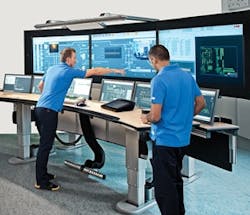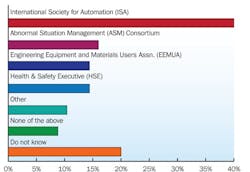Check out ControlGlobal.com on Google+ and Keith Larson's Google+ profile.
While the first distributed control system (DCS) represented a step-change in process control capabilities, it was a mixed bag at best for the process operator.Gone was his familiar wall-full of analog electronic controllers, immediately recognizable as all "lined out" when the plant was running properly. Instead, he peered with reduced visibility through a much smaller CRT, toggling among simulated controller faceplate displays and process graphics peppered with alphanumeric data, granular detail sometimes obscuring the big picture view of overall process conditions. Instead of encouraging collaboration like the old wall did, others had to crowd over his shoulder just to see what was going on. And if something actually did go wrong, cascades of too many alarms (that now came "free" with every measurement) made it even more difficult to determine just what was really causing the upset—and what corrective action to take.
Today, the amount of raw data available to operators continues to explode even as the scope of operator responsibilities increases. Now as then, the challenge for designers of human-machine interfaces (HMIs) remains a balancing act: How do you make sure that operators are presented with all the information they need to make a timely decision, while excluding what they don't? How do you make deeper levels of process and plant data readily available, but prevent the obscuration of critical alerts? How do you make navigation of integrated information from the process control system—as well as dozens of complementary plant information systems—intuitive, seamless and context-sensitive?
Toward 'High-Performance' HMI
System 800xA allows customization based on users' preferences and needs with individualized menus, toolbar contents and display locations. Custom, role-dependent workplaces present information consistent with individual work processes and appear automatically on user log-in.
Windows management functions such as safe areas and the pinning and stacking of priorities help manage multiple process views. A new trend display always opens in the same window as the previous, and an alarm list is never covered by another view. As well as saving time and minimizing stress, this no-surprises view-handling simplifies the use of multiple monitors so that operators can supervise and control larger process areas with the same efficiency and safety. Within the displays themselves, information can be mixed and matched regardless of source.
Today's System 800xA process graphics not only provide graphics builders with better engineering tools, they also give process operators a much-improved image to view. True vector graphics, for example, enable scaling with maintained resolution. This effect is especially appreciated when operators need to scale-down graphic image windows to fit several on one screen.
Through the system's underlying Object and Aspect technology, the 800xA provides intuitive and easy access to all integrated information through a simple right mouse-click. Consistent, one-click navigation gives process operators more time to act: instead of spending time and energy looking for information, they can concentrate on informed decision-making and can share data with colleagues and field operators.
Trends Analysis and Alarm Management
Recent performance visualization is yet another System 800xA feature that improves operator insight. This HMI function displays the recent performance data of an object right next to the object graphic and its current status. Having recent operating values side-by-side with real-time status can alert operators to deviations before they develop into something more serious. Recent performance graphics can be shown at all times and for all objects — operators don't have to call up dedicated trend display windows.
Respondents to a recent survey of Control readers (see "The State of Operator Effectiveness") report using a broad range of industry standards to guide their HMI development efforts. The International Society of Automation's guidelines were most widely cited, reflecting the preponderance of U.S. respondents in the survey sample, but European standards also ranked highly. The reliance on internal standards and guidelines for HMI development also was mentioned by a number of respondents.
Further, System 800xA provides support for the implementation of high-performance alarm-management strategies with features such as alarm grouping, alarm shelving (operator-driven alarm suppression) and alarm hiding (condition-based alarm suppression). "Alarm Response" is an 800xA feature that allows up to four relevant operator displays to be invoked by simply clicking on an alarm in an alarm list. These displays should be selected based on operator best practices and can be configured consistently across the entire system, or individually on an instance or single tag object. This functionality is designed to give the operator a contextual "head start" on solving a problem regardless of his or her experience level. These features reduce the number of nuisance and non-critical alarms and so help end users meet or exceed current guidelines and standards such as those from Europe's Engineering Equipment and Materials Users Assn. (EEMUA) and the International Society for Automation (ISA).
ABB's alarm management is fully built into System 800xA, which improves navigation, analysis and handling; it also costs much less than running and maintaining a standalone or integrated alarm management system. Without a separate system to distract them, operators can devote more time to running a safe and efficient process. Plus, the operator need only point to any alarm list in the system to generate alarm performance metrics—no rules files, parsing of data or connecting of OPC interfaces.
And because every relevant fact and event is accessible in one system, operators get consolidated time-stamped alarm lists that include information from power systems, safety systems and all controllers irrespective of brand or supplier. This all leads to an improved overview of what has happened in the process (and in exactly what order) plus what is happening right now. Troubleshooting is faster and more effective.
System 800xA also gives operators full insight into current alarm management key performance indicators (KPIs) including the 20 most-frequent alarms, 20 longest-standing alarms, average time to acknowledge, and alarm priority distributions. Furthermore, these calculations are presented as easy-to-understand graphics, helping users identify troublesome alarms and address—once and for all—underlying process problems.
Of course, the mere possession of tools does not a mechanic make. To that end, ABB provides a range of Consulting Services—from help implementing alarm management strategies to educational programs on how to run successful alarm management programs and projects. The company's "packaged" services are designed to be purchased with an 800xA license and provide continued training on the system's extended functionality and possible ways to implement them. This relieves the initiative burden from the end user, and sets them up for success.








